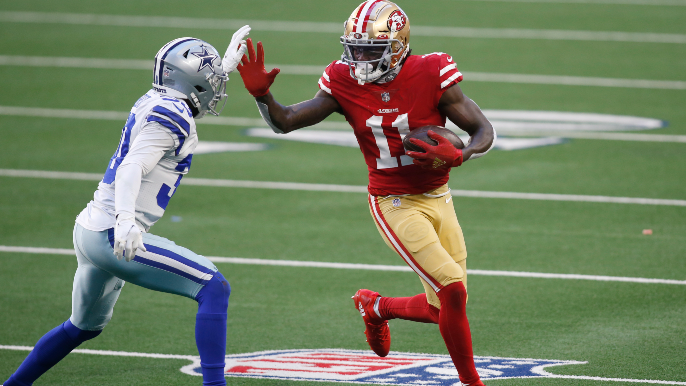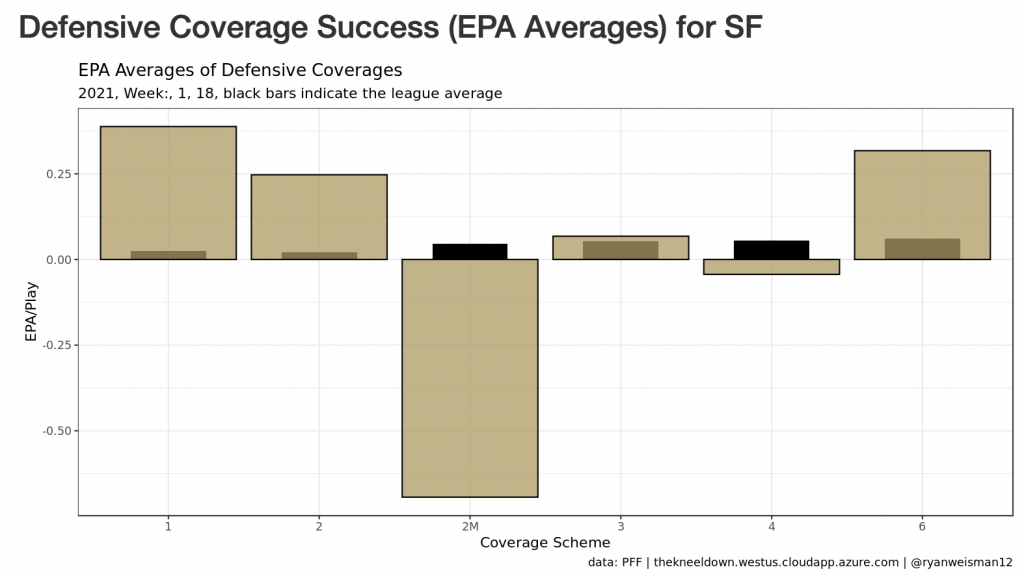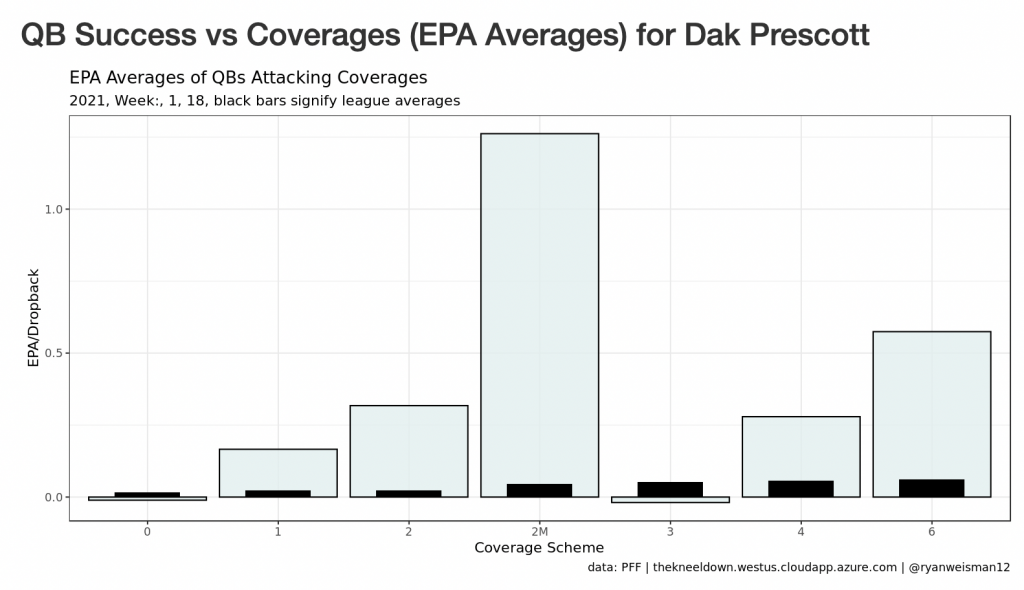
This isn’t the 90s, but if we get even a taste of the old 49ers-Cowboys rivalry this Sunday, it would be a welcome sight, at least for neutral NFL fans.
For the first time since 1995, these two teams are meeting in the playoffs. It’s a rivalry which favors the Cowboys 5-2 all time, but has been split 2-2 since it began in earnest, with The Catch in 1982.
But as Kyle Shanahan recollected on Monday, most of his players are “not at all” familiar with the rivalry.
The game has evolved, and neither of these two teams are coming out of this regular season with the same level of dominance as when this rivalry began. Both have major flaws, and are not the titans they were, or would become when the rivalry peaked.
Still, there is explosive, young talent at key positions for both teams, and it’s the tightest point spread of Wild Card weekend.
What to look for
The 49ers come into this game, by most books, as three-point underdogs, which is essentially a reflection of an even game with a home field advantage.
San Francisco should be the favorites despite Dallas’ home field advantage.
Their early-season inconsistencies, defined by an untenable number of turnovers, a failure to execute on third down and a failure to effectively perform basic parts of the offense sent them to 3-5.
Jimmy Garoppolo threw the game away against the Titans and we went back to square one, with San Francisco having to pull off the comeback of all comebacks against the Rams.
But for the second half of the year, this has been a team with elite run and pass blocking, which has thrived on the one-two rushing punch of Elijah Mitchell — who broke the 49ers’ 50-year-old single-season rookie record with 963 rushing yards — and Deebo Samuel, whose eight rushing touchdowns are the most for a receiver in a season in NFL history.
Their coverage, though still underwhelming, has improved since the start of the year, especially in avoiding the deep pass interference calls which plagued them.
Since moving Arik Armstead inside full time, Arden Key and others have thrived, with the defensive line becoming an unquestionably elite unit in the league.
This is all to say the 49ers, though still unpredictable, have generally been in control of their own fate, aside from the bizarre blowout loss against the Colt McCoy-led Arizona Cardinals. Jimmy Garoppolo, a deeply inconsistent quarterback, will be the arbiter of this team’s fate, and against a Dallas defense which led the NFL with 34 turnovers (and a league-leading 26 interceptions), there’s a clear path for this game to spiral out of control.
Disjointed play from Cowboys’ offense
Dak Prescott looked absolutely woeful two weeks ago against the Arizona Cardinals. The entirety of the Dallas offensive line, including future Hall of Famer Tyron Smith, were waxed. Dalton Schultz, their tight end, was frequently put in one-on-one blocking situations which he had no business being in, especially against Chandler Jones. He’s struggled in pass blocking in recent weeks.
Much of this is on the line and Prescott, but it’s also on offensive coordinator Kellen Moore, one of the supposed golden boys of the NFL who many believe is in line for a head coaching job. The Minnesota Vikings are reportedly interested in both him and 49ers’ defensive coordinator DeMeco Ryans, which figures to be a major resume booster for one of them.
This isn’t at all to say that Moore is a bad play-caller, but as Kyle Shanahan said earlier this season, there’s a rhythm to it. Early on, he had failed to find that rhythm, and eventually went all in on Garoppolo and found it.
Right now the Cowboys look out of rhythm offensively.
There was no clearer indication of that than the fact that Dak Prescott and the first-team offense played deep into last week’s regular-season finale, a 51-26 beatdown of the Eagles.
Philadelphia, which had already notched its Wild Card spot and was resting most of its starters, took that beating discernibly so Mike McCarthy could have his team feel like they weren’t frauds. It was basically a varsity team playing a JV team in the name of boosting the Cowboys’ confidence.
Maybe that worked, but it’s hard to give them much credit for playing against a practice squad roster. Their penultimate regular season game against the Cardinals was much more concerning.
Moore improved against Arizona towards the end, pulling off a brilliant trick play, cross-field receiver pass to reignite the offense, and Prescott came alive. But for much of that game, the scheme was dry and Prescott was woeful.
Prescott appeared to have misidentified coverage or failed to make the correct read on a handful of throws. While he made solid reads most of the time, but had some underthrown or poorly thrown passes.
Sometimes this was due to pressure, and as that accumulated, Prescott looked less confident and understandably jumpy in the pocket. When Moore dialed up something impressive, Prescott either missed it or was let down by his receiver, and Prescott sometimes had to fend for himself on some of the underwhelming calls.
This is all without mentioning the run game, which for all intents and purposes, was nonexistent against Arizona.
Dallas ran the ball 17 times for 45 yards, with most of those coming on an escape from Prescott, their leading ball-carrier at five carries for 20 yards. Their backs, Ezekiel Elliot and Tony Pollard, averaged 2.08 yards per carry.
This is a team, which from Weeks 8 to 17 — excluding the stat-skewed finale against the Eagles, who were resting most of their starters — averaged just 3.9 yards per carry, which would rank tied for fourth-lowest over the course of the season.
49ers’ defense matches up well in most areas, except one
Against a San Francisco defense which has been outstanding against the run over the second half of the year, that failure to run effectively is a recipe for Moore and Prescott turning to the pass game early. Moore has shown a predilection towards the pass game already, plus an impatience towards running the ball (understandably) when it continues to fail, as was the case in Arizona.
As Greg Cosell outlined on KNBR this week, Dallas will abandon the run game, which also means a less physically-taxing game for the defense.
The 49ers have allowed 4.0 rush yards per carry (seventh-best), and a league-best 3.1 yards per carry over the last three games.
From Week 10 through 18 just one team, the Seattle Seahawks — thanks to a 73-yard fake punt touchdown — have surpassed the 100-yard rushing mark against them. The 49ers have allowed 3.6 yards per carry over that stretch, and it’s just 3.2 yards excluding that fake punt.
Defensive coordinator DeMeco Ryans credited Arik Armstead sliding inside full time starting in Week 8, and D.J. Jones for the stellar run defense.
“I think our run defense improved drastically because of the unselfish play by [DL] Arik Armstead,” Ryans said. “I think people kind of forget we lost our starter in [DT Javon] Kinlaw early in the year and we were trying to figure that out inside. When you want to play good run defense, you have to have two really good interior defense lineman.
“And Arik unselfishly moving inside and [DL] D.J. Jones has been outstanding all year. He has had a dominant year, a career year inside and he’s been consistent all year. That’s why our run defense has been better because of Arik and his play. Arik continued to get better and better inside as the year went on. And D.J. has been as consistent as ever this year.”
Advanced stats support that, and clearly.
Per ESPN, Jones had the highest run stop win rate in the NFL at 48 percent. Armstead finished third, at 43 percent, while simultaneously rushing the passer solidly from the inside.
This is all to say it’s a Cowboys offense with an abysmal run game against an elite run-stopping defense. The Cowboys will rely on the passing game, where Prescott has been uneven and has not been in rhythm with his play-caller, Moore.
They will have to take shots at Ambry Thomas, who has allowed the second-most yards per reception in the NFL at corner, only behind… Trevon Diggs. But he’s looked much more confident and reliable over the last few games.
After an abysmal start to the year, he’s graded out as an effective player, per PFF, over the last three, and he’s opposite Emmanuel Moseley, a solid corner. The 49ers’ secondary is the strongest, arguably, it has been all year, with both Jimmie Ward and Jaquiski Tartt available in both center field and inside-the-box roles.
Prescott is at his best taking deep shots on third downs.
What’s intriguing for the 49ers is that he struggles against Cover-3 more than any other coverage scheme he’s faced this season, and that’s San Francisco’s bread-and-butter, though it’s often disguised as Cover-2 or Cover-4 with a safety motioning late into the box as a robber.
Cover-4 and Cover-1 (man coverage with a single-high safety) are the next two most-used coverages. San Francisco’s most effective coverage has actually been Cover-2 man, but it’s only been used a handful of times this season, whereas Cover-3 and Cover-4 have clearly been their most effective coverages.
Here’s a good visualization of that, per The Kneeldown, a useful site that shows how often teams employ defensive coverages, among other things. EPA stands for Expected Points Added. For a defense, a negative number is a good thing, so the lower the bar, the better.

Against Prescott, teams have used Cover-3 an outsized proportion of the time, far more than the league average. And you can see why.
Prescott has absolutely shredded Cover-2 man, and basically anything that’s not Cover-3 or Cover-0.

So the 49ers are facing a quarterback who struggles against their favorite coverage. That showed up against Arizona, when Prescott either failed to attack the seam — which is generally the weak spot against routes like the skinny post Brandon Aiyuk ran so often — Moore failed to call plays that were advantageous against it, or a combination of receiving or blocking failure ruined the opportunity to attack the coverage.
Against a team which is getting more comfortable in coverage generally, let alone the one the Cowboys offense has struggled to attack most frequently, that could be an issue.
Oh, and for the first time this year, the linebacker trident of Fred Warner, Dre Greenlaw and Azeez Al-Shaair are all expected to be available. All, especially Warner, are rangy, solid coverage defenders, and Warner has a knack for sinking quietly into deep coverage, where Prescott has thrown eight of his 10 inteceptions this season.
This is the healthiest the 49ers’ defense has been, and it’s while they’ve been playing their best football against a team that was so devoid of confidence it needed a warm-up game last week.
Explosive youth versus scheming
Trevon Diggs made the NFL’s All-Pro team, which seems a gross mis-assessment. He is an all-or-nothing corner with elite ball skills and length, which is how he led the league with 11 interceptions and had two touchdowns on returns. But that tendency and perhaps an unrefined technique leaves him very vulnerable to major yardage.
Diggs allowed 55 receptions for 1,016 yards and 5 touchdowns on 92 targets.
Those 1,016 yards allowed were by far the most in the NFL. Marshon Lattimore allowed the second-most yardage at 862 yards. His 18.5 yards allowed per catch was the worst among NFL corners, and third-worst overall.
*Whispering* The corners with the most yardage allowed per catch after Diggs were Deommodore Lenoir, Ambry Thomas and Ahkello Witherspoon.
Diggs isn’t an innately bad corner, but he’s not technically sound at this point in his career. In some games, his risky plays are rewarded. In other, they’re punished, and that’s why teams continue to target him so frequently. Most of the time, he’s getting beat.
Is one interception worth getting beat more times than not? It’s sort of a philosophical question, and the answer comes on a game-by-game basis.
You can be sure Kyle Shanahan will try to get a feel for his tendencies and look to exploit them, but Jimmy Garoppolo has the second-highest percentage of turnover-worthy plays this season at 4.6 percent (second to Tua Tagovailoa at 4.8 percent), though most of those come over the middle of the field on overthrows or forced throws into nonexistent windows.
Eleven of Garopppolo’s 12 interceptions have come inside the numbers, and nine of those 12 have been between the hashes. So the more pressing concern is about Dallas’ safeties — Jayron Kearse, Damontae Kazee and Malik Hooker — and linebackers, namely Leighton Vander Esch, who have six combined interceptions this season.
Then there’s Micah Parsons.
Parsons has been the most effective edge rusher in the NFL this season and is an unparalleled, uniquely-skilled disruptor. He got my vote for Defensive Player of the Year and Defensive Rookie of the Year. He’s a menace.
But he and the Cowboys offense have not seen a team which motions as frequently, or as dynamically as the 49ers. The only other competitive team the Cowboys faced who motion a similar amount are the Chiefs, who they lost to by 10, with Parsons being used as a pass rusher more than two-thirds of the time.
That’s all to say, Parsons hasn’t been tested all that frequently in playing the middle linebacker patiently and maintaining eye positioning to track the ball and stay in his gap. Most of that duty has fallen to Vander Esch and may fall further on Parsons shoulders without Keanu Neal in the lineup.
Garoppolo delivers the ball in 2.53 seconds on average, so the opportunities for some of the slower dropbacks which allow consistent pressure might not be there.
But on paper, a pass rush of Demarcus Lawrence, Randy Gregory and Parsons is an absolutely terrifying prospect. Lawrence missed half the season but has looked more like himself, while Gregory hasn’t been the same player since suffering a Week 9 calf injury. Regardless, that battle, with Trent Williams back in the lineup, will be extremely interesting to watch.
This is a matchup in which Shanahan will have creative ways to scheme around Parsons and attack Vander Esch and the rest of the defense. You can’t silence Parsons, but he and the Cowboys will be seeing an offense that is deceptive pre-snap, demanding patience and confident, sound scheme adherence, and is extremely physical post snap.
Recap:
- San Francisco’s defense is as healthy and confident as its been all year and leans on Cover-3, which has troubled Dak Prescott and the Cowboys more than any other this season. The defensive line has been getting home consistently, and the Dallas offense has looked out of sync recently, using the final regular season game against a threadbare Eagles team to boost confidence.
- Dallas creates the most turnovers of any defense, and Garoppolo is one of the most turnover-prone quarterbacks in the league. However, Trevon Diggs’ 11 interceptions represent the overwhelming bulk, and most of Garoppolo’s interceptions come on the interior. He also gets the ball out quick, and with Dallas down a linebacker, Micah Parsons could see more snaps where he’s forced to be sound in coverage against an extraordinarily deceptive offense, which Dallas hasn’t seen too much of this season. When it has, he’s mostly been used as an edge rusher.

